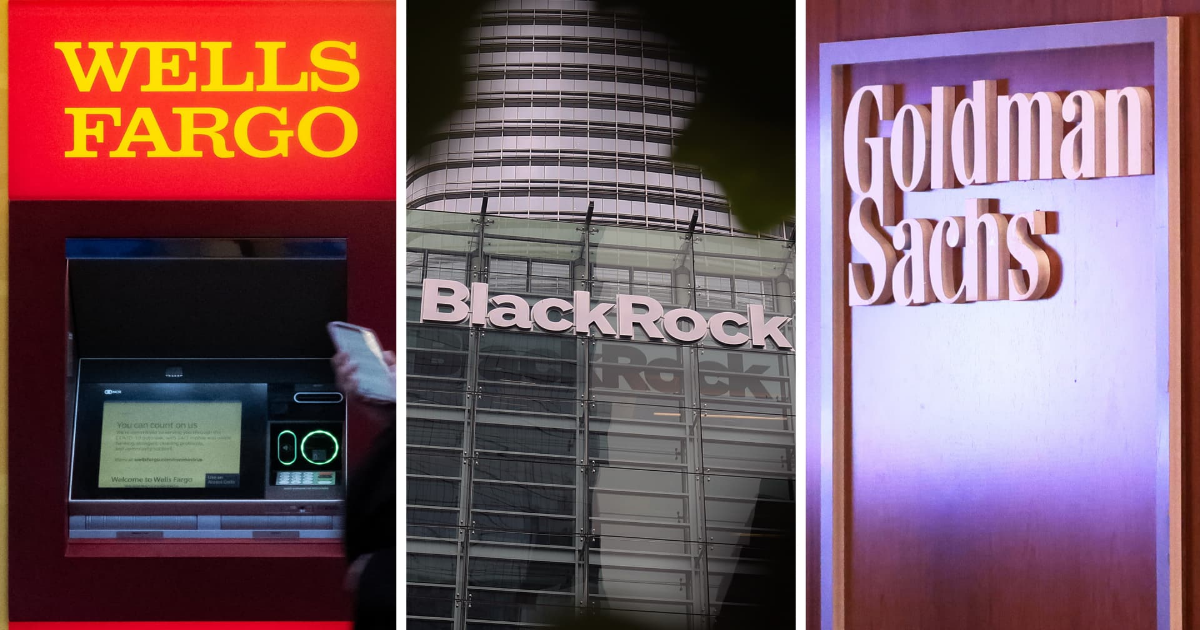Wall Street analysts are striking a cautious tone on three of our financial names after President Donald Trump unveiled broad-reaching tariffs and the stock market plunged. Club stocks Goldman Sachs and Wells Fargo were each dropping more than 7%. BlackRock was down nearly 6%. All of the declines were steeper than the overall financial sector and the S & P 500 . Jim Cramer called one of them a buy. The news JPMorgan slashed its price targets and earnings estimates for Wells and Goldman, along with many other U.S. banks, ahead of earnings season later this month. “Banks would be impacted by these [tariffs] with fallout on investment banking, consumer spending, and loan growth plus wealth management,” the analysts wrote on Thursday. “Consumer spending started to slow in 1Q, which would impact economic growth, and inflation could rise with tariffs.” JPMorgan also warned investors of the “potential for further cuts” to these figures based on the full impact of Trump’s aggressive new trade policies. JPMorgan analysts lowered their Goldman price target to $614 per share from $625. Shares closed Wednesday at $563 each but sank below $520 on Thursday afternoon. JPMorgan maintained its buy-equivalent rating. In the case of Wells Fargo, the analysts brought down their price target to $73.50 from $82. Shares closed Wednesday at $81.50 each but fell to around $67 on Thursday afternoon. JPMorgan reiterated its neutral rating. On Wednesday, Bank of America lowered its price target on Wells to $83 from $85 for similar reasons but maintained its buy rating. It’s not just big banks. Wall Street expressed concerns about asset managers like BlackRock, too. BofA lowered its BlackRock price target to $1,178 from $1,196 and kept its buy rating. Shares closed Wednesday at $1,084 but dropped to roughly $902 on Thursday afternoon. The analysts argued that a deepening U.S. stock market correction poses a risk to fund flows and fee rates for asset managers like BlackRock. Big picture The price target changes come ahead of the financial sector’s first-quarter earnings. Wells Fargo and BlackRock will both release results on April 11, while Goldman Sachs will post later in the month. The reported quarter should give investors a glimpse into how these companies have navigated Trump’s first few months back in office but not the impact of Thursday’s blanket tariffs. We’ll be eager to hear about that in the post-earnings conference calls when management looks ahead to the current second quarter and the full year. Wall Street had high hopes coming into 2025 that the new administration would create a friendlier environment for mergers and acquisitions (M & A) and initial public offerings (IPOs) due to Trump’s lighter stance on regulation and antitrust matters. That hasn’t been the case yet as the president’s barrage of tariffs rocked the market on concerns of a recession and an all-out global trade war. Case in point: Jefferies’ lackluster earnings report last week was weighed down by weakness in investment banking. That’s a crucial business to Goldman Sachs as well. Bottom line Among the three, Wells Fargo is the most insulated from Trump’s tariffs. Jim sees the stock as a buy at these levels, and would have added more shares to the portfolio had he not been restricted by the Club’s trading rules. Tariffs are not much of a headache for Wells because it derives 100% of its revenue from the U.S. “These are just recession fears. Wells Fargo is a completely domestic bank,” Jeff Marks, director of portfolio analysis for the Investing Club, said Thursday. “It’s well capitalized and has a good operator” in CEO Charlie Scharf. Jim also cited a key catalyst for Wells Fargo that could finally happen this year — the expected removal of the $1.95 trillion asset cap that the Federal Reserve imposed on the bank in 2018 following a series of scandals under prior management. Lifting the cap would allow Wells Fargo to further diversify its revenue streams — making the bank less reliant on interest-based income, which is at the mercy of Fed monetary policy. “Charlie Scharf has done a remarkable job here,” Jim said during Thursday’s Morning Meeting. It would be unwise, however, to dismiss analysts’ caution entirely. Higher tariffs on imports can lead to higher prices and weigh on the pocketbooks of U.S. consumers. That, in turn, could soften the demand for loans and slow spending. Those factors have a direct impact on Wells Fargo as a traditional lender. As for BlackRock and Goldman, we’re chalking up their respective Thursday declines to concerns about economic growth, rather than fundamentals. Goldman Sachs’ investment banking business is key to its bottom line. More macroeconomic uncertainty typically makes clients conservative with capital, which could leave companies on the sidelines when it comes to new deals. A possible offset for Goldman could be stronger trading volume due to the market volatility. That same volatility offset could be said for BlackRock on the trading side. But fearful investors tend to take their money out of stocks and mutual funds during this time, especially exchange-traded funds, which are a big business at BlackRock. (Jim Cramer’s Charitable Trust is long BLK, WFC, GS. See here for a full list of the stocks.) As a subscriber to the CNBC Investing Club with Jim Cramer, you will receive a trade alert before Jim makes a trade. Jim waits 45 minutes after sending a trade alert before buying or selling a stock in his charitable trust’s portfolio. If Jim has talked about a stock on CNBC TV, he waits 72 hours after issuing the trade alert before executing the trade. THE ABOVE INVESTING CLUB INFORMATION IS SUBJECT TO OUR TERMS AND CONDITIONS AND PRIVACY POLICY , TOGETHER WITH OUR DISCLAIMER . NO FIDUCIARY OBLIGATION OR DUTY EXISTS, OR IS CREATED, BY VIRTUE OF YOUR RECEIPT OF ANY INFORMATION PROVIDED IN CONNECTION WITH THE INVESTING CLUB. NO SPECIFIC OUTCOME OR PROFIT IS GUARANTEED.Wells Fargo, Blackrock and Goldman Sachs.
